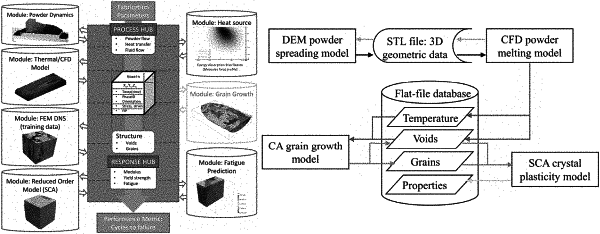| CPC G06F 30/23 (2020.01) [G06F 30/27 (2020.01); G06T 17/20 (2013.01); B33Y 50/00 (2014.12); G06F 2111/10 (2020.01); G06F 2113/10 (2020.01); G06F 2119/08 (2020.01)] | 16 Claims |

|
1. An integrated process-structure-property modeling framework for design optimization and performance prediction of a material system, the framework comprising:
one or more processors;
a memory;
a database; and
a plurality of models coupled with the database, comprising process models and mechanical response models, each model being coupled to the next by passing output information to the one or more processors, wherein the process models comprise a powder spreading model, a powder melting model and a grain growth model, and the mechanical response models comprise a self-consistent clustering analysis (SCA) model, a finite element method (FEM) model and a fatigue prediction model, wherein the powder spreading model is a discrete element method (DEM) powder spreading model, the powder melting model is a computational fluid dynamics (CFD) powder melting model, the grain growth model is a cellular automaton (CA) grain growth model, and the SCA model is an SCA crystal plasticity model;
wherein the memory stores instructions that, when executed by the one or more processors, implement the plurality of models;
wherein the powder spreading model and the powder melting model operably exchange geometry information of a powder bed using a stereolithography (STL)-format surface mesh representation;
wherein the powder melting model operably predicts a temperature profile in each volume of interest (VOI) with a powder melting simulation, wherein the temperature profile is written to the database in a flat file format, and wherein a void space is set to an ambient temperature to distinguish said void space from a dense material;
wherein the grain growth model operably accesses the temperature profile and void information from the database, and predicts grain information based on the temperature profile and the void information, wherein the grain information is written to the database along with voids, and wherein the dense material and the voids are identified based on the temperature profile, and the voids and free surfaces are thereby included in the grain growth model;
wherein the SCA and FEM models are used, based on the grain and the void information provided at each point via the database, to predict stress-strain responses, wherein the stress-strain responses are written to the database; and
wherein the fatigue prediction model operably accesses the stress-strain responses at each point via the database, and computes a non-local potency estimate based on the stress-strain responses, wherein a fatigue life of a highest potency location is computed to provide a scalar material response metric.
|